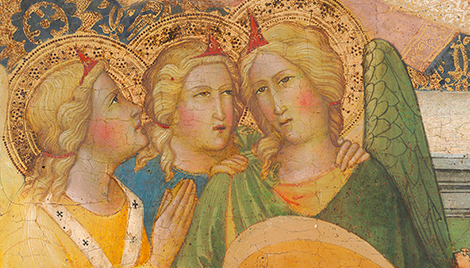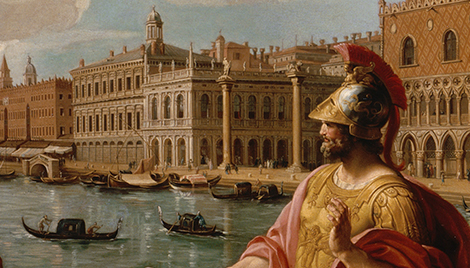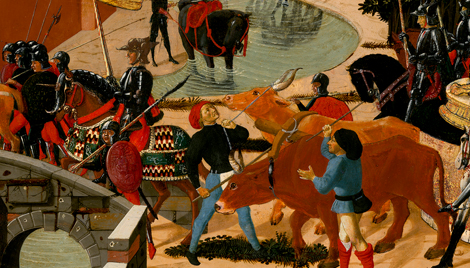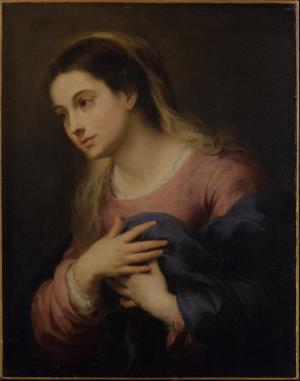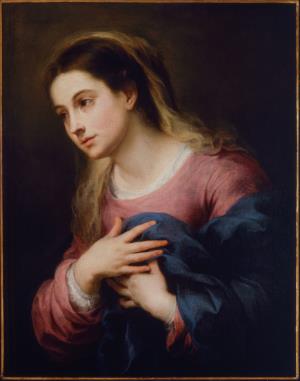The Virgin of the Annunciation
The Virgin of the Annunciation
- Artist
- Bartolomé Esteban Murillo
- Artist Dates
- 1617-1682
- Artist Nationality
- Spanish
- Title
- The Virgin of the Annunciation
- Date
- 1670-80
- Medium
- oil on canvas
- Dimensions
- 72.4 x 57.2 cm (28-1/2 x 22-1/2 in)
- K Number
- K1866
- Repository
- Museum of Fine Arts, Houston
- Accession Number
- 61.70
- Notes
Provenance
Anonymous Collection, Seville, Spain. Joseph Bonaparte [1768-1844], King of Naples and Spain. Wynn Ellis [1790-1875], London; (his sale, Christie's, London,17 June 1876, no. 36); bought by (Waters) or (John Charles Robinson). [1] Sir Francis Cook, 1st Bart. [1817-1901], Doughty House, Surrey; by inheritance to Sir Frederick Lucas Cook, 2nd Bart. [1844-1920] Doughty House; by inheritance to Sir Herbert Frederick Cook, 3rd Bart. [1868-1939], Doughty House; by inheritance to Sir Francis Ferdinand Maurice Cook, 4th Bart.. [1907-1978] Doughty House; (Rosenberg and Stiebel, Inc. New York); sold to the Samuel H. Kress Foundation on 23 October 1951; gift 1961 to the Museum of Fine Arts, Houston, no. 61.70. [1] Differing annotated sale catalogues give Waters or Robinson (J.C.R.) as buyer, but according to Colin Eisler, Paintings from the Samuel H. Kress Collection: European Schools Excluding Italian, Oxford, 1977, p. 219, Waters was the purchaser. Robinson did buy many paintings for Cook at auction, it is possible Waters was buying for Robinson.
Catalogue Entry
Bartolomé Esteban Murillo
The Virgin of the Annunciation
K1866
Houston, Texas, Museum of Fine Arts (AC 61-70), since 1953. Oil on coarse canvas. 28 1/2 x 22 1/2 in. (72.4 x 57.2 cm.). Considerable abrasion. Restoration in area of left eye and where thumb joins hand. Cleaned and restored shortly before 1951.(1) Houston, 1953, pl. 35. The Virgin is shown in half-length, her face in threequarter view. She looks and turns to the left, a yellow scarf on her head and shoulders. Clad in a pink robe, her hands are closed over a blue mantle at her breast. The Kress canvas was first described as an Annunciation by Waagen.(2) It is listed as the Virgin Annunciate in Curtis's Murillo with the suggestion that it was a study for an Annunciation.(3) The painting was dated c. 1670-80 by Mayer,(4) while Munoz dated it 1660-70.(5) The painting is placed in the following decade by Gaya Nuño who described it as a section from an Annunciation.(6) The model in K1866 is typical of Murillo's Virgins, her pose is characteristic of such Annunciations as that in the Wallace Collection, London. The pink and blue drapery is also Marian. The painting is highly finished and was presumably cut from a much larger work in which Mary was shown kneeling at the right with Gabriel at the upper left. Mayer's original dating of 1670-80 was set back a decade by Muñoz. However, the model appears to be the same as the one for the Mary in the 'Pedroso' Double Trinity (London National Gallery), dateable to the late 1670s, lending some credence to Mayers's placement, according to Marcus Burke.(7) The canvas is close in technique to the Virgin and Standing Christ Child (Florence, Pitti Palace) dated 1650-55 by Muñoz. Despite his productivity and equally great popularity, singularly little is known of the chronology of Murillo's works. Provenance: Prince Joseph Bonaparte (according to Wynn Ellis sale catalogue, 1876).(8) Wynn Ellis Collection (sold Christie's, 17 June 1876, p. 7, Cat. No. 36, as Virgin in Prayer), purchased by Waters.(9) Sir Francis Cook as early as 1883.(10) Sir Frederick Cook, until 1920. Sir Herbert Cook, until 1939. Sir Francis Ferdinand Cook. New York, Rosenberg and Stiebel. Kress acquisition 1951. Exhibited –Washington, D.C., National Gallery of Art, Art Treasures for America from the Samuel H. Kress Collection, 10 Dec. 1961 - 4 Feb. 1962, Cat. No. 70.
References
(1) See August Liebmann Mayer, Murillo, Klassiker der Kunst, Berlin, 1912, pl. 168, for the appearance of K1866 before more recent restoration. (2) Gustav Friedrich Waagen, Treasures of Art in Great Britain, London, 1854, II, p. 295, Wynn Ellis Collection, No. 2. 'The Annunciation, half-length figures [sic], a tender and delicate contrast to the foregoing.' No. 1 was another Murillo in the collection, St. Joseph and the Christ Child. Perhaps K1866 was then part of a larger canvas including the archangel Gabriel at the left. (3) Charles B. Curtis, Velasquez and Murillo, London and New York, 1883, p. 148, Cat. No. 74. K1866 is also in Paul Lefort, Murillo, Paris, 1892, p. 74, Cat. No. 72, as 'La Vierge'. (4) Mayer, op. cit., pl. 168. (5) Antonio Muñoz, Murillo, Rome, 1942, p. xxix, and pI. 113. (6) Gaya Nuño, p. 253, Cat. No. 1975. (7) For the dating of the Double Trinity see Alan Braham, The Spanish School, National Gallery, London, 1970, pp. 61 ff. (8) Possibly acquired c. 1810, the time of the Napoleonic invasion of Seville. The Kress canvas may have been among the paintings removed from royal palaces and suppressed convents and distributed among several French generals by Joseph Bonaparte, according to a decree of 4 Jan. 1810. Many presented to General Dessolle came to England, and were purclused from Dessolle's daughter by Woodburn. See W. Stirling-Maxwell, Annals of the Artists of Spain, 1848, II, p. 1397. (9) Noted in Herbert Cook, A Catalogue of the Paintings at Doughty House, Richmond, London, 1915, III, p. 161, Cat. No. 524. An annotated catalogue of the Wynn Ellis Sale gives the purchaser as J. C. R. [John Charles Robinson]. (10) Maurice W. Brockwell, Abridged Catalogue of Pictures at Doughty House, Richmond, Surrey, London, 1932, p. 58, Cat. No. 524.

